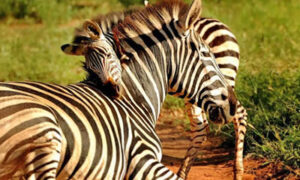Tsavo East National Park.
Tsavo East National Park is the larger of the two Tsavos, covering about 13,747 square kilometers (5,308 square miles). The park includes the Yatta Plateau, the world’s longest lava flow, which was generated by past volcanic activity and spans over 290 kilometers (180 miles).
The rather flat, semi-arid plains and savannahs are covered in scrubland and interspersed with massive baobab trees. This plateau offers a distinct geological setting but lacks the dramatic terrain found in Tsavo West National Park.
The park gained notoriety in the late 1890s as a result of the “Man-Eaters of Tsavo,” a lion pride that preyed on Indian migrant laborers building the railway. Over 130 people were killed; the episode was recounted in the 1996 thriller The Ghost and the Darkness, starring Val Kilmer.
Attraction of parks.
Mudanda rocks.
 Mudanda rock in Tsavo East National Park is a 1.6-kilometer-long inselberg of stratified rock that serves as a water collecting point for the natural dam located below it as well as a watering location where animals gather to drink water, particularly during the dry season.
Mudanda rock in Tsavo East National Park is a 1.6-kilometer-long inselberg of stratified rock that serves as a water collecting point for the natural dam located below it as well as a watering location where animals gather to drink water, particularly during the dry season.
A wonderful observation location in the park, utilized by many tourists to see animals such as elephants, wildebeests, and buffaloes that come to drink.
Yatta Plateau
The Yatta plateau is one of the fascinating features in the Tsavo East National Area and a must-see feature while on a Kenya safari in the area.
The world’s longest lava flow of 290 kilometers was created as a result of lava that erupted at OlDoinyo-Sabuj Mountain during the eruption process.
Yatta plateau runs along the western border of Tsavo East national park above Athi River.
Lugard falls.
Lugard Falls is a sequence of whitewater rapids generated in the Galana River.The falls (Lugard Falls) were named after Frederick Lugard, a British explorer and colonial governor who arrived in Mombasa in early 1888.
Galana and the Tsavo River
 The Galana and Tsavo rivers intersect the park, and these two rivers are important water supplies for the area’s biodiversity. The Tsavo River flows through two Tsavo national parks before joining the Athi River to form the Galana River, which is filled with crocodiles, giving an amazing watch.
The Galana and Tsavo rivers intersect the park, and these two rivers are important water supplies for the area’s biodiversity. The Tsavo River flows through two Tsavo national parks before joining the Athi River to form the Galana River, which is filled with crocodiles, giving an amazing watch.
The Galana River originates in the south-east Kenyan highlands and runs through Tsavo East National Park.
Kanderi Swamp
Kanderi swamp is one of the water sources that support the ecosystem of Tsavo East National Park, as well as one of the park’s most stunning tourist attractions. The swamp is located along the Voi River, which serves as a water source for a large variety of species. An excellent location for Kenya wildlife viewing safaris, and game drives provide opportunities to see elephants, buffaloes, antelopes, and hartebeests, among other creatures.
Aruba Dam
Aruba Dam is a water reservoir in Tsavo East National Park, erected in 1952 along the Voi River.
The dam draws thousands of animals of Tsavo National Park, especially during the dry season, and these animals swarm the dam to drink water. Here are also a variety of birds that live around the dam.
Wildlife
Tsavo National Park has a documented population of 675 animal individuals, including a large population of lions for which the park is famed. Tsavo East National Park’s wildlife species include animals and primates.
Elephants, leopards, cheetahs, buffalos, black rhinos, gazelle, impala, aardwolf, Grevy’s and plain’s zebra, warthog, waterbucks, warthogs, civet, dik-dik, caracal, African wildcat, African hunting dog, duikers, eland, African dormouse, stripped and spotted hyena, tree hyrax, black-backed and side-striped jackal, lesser kadu, gazelles, small spotted genet and the greater gala, among others.
Bird Life
These birds include both resident and migrant species. Migrant species travel from Europe and northern Africa and arrive in Tsavo East National Park between November and April.
The park is a fantastic bird habitat in Kenya, and Tsavo East National Park should be at the top of your list.
This park is recognized as one of the best sites for Kenya birding safaris, with over 500 species.
 Ostriches, kestrels, buzzards, starlings, weaver birds, kingfishers, hornbills, secretary birds, herons, eastern chanting-goshawk, eurocephalus, female eastern paradise, golden pipit, martial eagle, Rufous chatterer, slender-tailed nightjar, Somali bee-eater, Shelley’s starling, African fin foot, lesser kestrel, and many others have been spotted in Tsavo East National Park.
Ostriches, kestrels, buzzards, starlings, weaver birds, kingfishers, hornbills, secretary birds, herons, eastern chanting-goshawk, eurocephalus, female eastern paradise, golden pipit, martial eagle, Rufous chatterer, slender-tailed nightjar, Somali bee-eater, Shelley’s starling, African fin foot, lesser kestrel, and many others have been spotted in Tsavo East National Park.
Best time to visit
The best time to visit Tsavo West National Park is during the dry season, which provides excellent wildlife viewing possibilities.
Dry Season (June-October and December-February)
The grass is shorter and drier, making it easier to detect species which concentrate around scarce water sources.
Expect increased visitor numbers and lodging costs during these months, particularly in July and August, when international travelers coincide with summer vacations in Europe and North America.
Wet Season (March–May and November)
The wet season is ideal for bird watching since migratory species are present and the terrain grows rich with greenery.
During this period, visitor numbers are reduced, resulting in a more relaxing atmosphere.
However, this season has certain challenges: roads may become muddy and difficult to navigate, thereby limiting safari activities.
Because of the abundance of food and water, wildlife may be more spread.
How to Get to the Park.
Getting to the park is easy because there are numerous ways to get there, which include:
By Air.
Scheduled and charter flights connect Nairobi’s Wilson Airport and Mombasa’s Moi International Airport to these airstrips.
Tsavo National Park has multiple airstrips for easy access, including Voi, Aruba, Satao, Sala, and Bachuma.
By train.
Trains from Nairobi to Mombasa stop at Tsavo Station, which is located within the park.
By Road.
The distance is approximately 240 kilometers (150 miles), which takes about five hours to travel. Tsavo East’s Manyani Gate is approximately 233 kilometers (148 miles) southeast of Nairobi.
Tsavo West is accessible from Mombasa via the Tsavo Gate, approximately 200 kilometers (125 miles) north of the city. The trip takes approximately four hours.
Tsavo East is around 157 kilometers (98 miles) northwest of Mombasa, with entry points like the Voi Gate and Buchuma Gate.
Book and plan your safari to Tsavo East National Park.
Preparing your safari with the best tour operators in the industry, having favourable tour packages, and thrilling through with experienced guides to bring out the best of your safari experience. Inquire about your trip to Tsavo with us.





